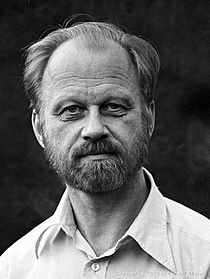Jürgen Moser facts for kids
Quick facts for kids
Jürgen K. Moser
|
|
|---|---|
 |
|
| Born | July 4, 1928 |
| Died | December 17, 1999 (aged 71) Schwerzenbach, Kanton Zürich, Switzerland
|
| Nationality | American |
| Alma mater | University of Göttingen |
| Known for | Kolmogorov–Arnold–Moser theorem Nash-Moser theorem Moser's Harnack inequality Trudinger's theorem Outer billiard Volterra lattice Calogero–Moser system Chern–Moser invariants De Giorgi–Nash–Moser estimates Moser normal form Moser iteration Moser's trick Moser twist theorem |
| Awards | George David Birkhoff Prize (1968) James Craig Watson Medal (1969) Wolf Prize (1994/1995) Cantor Medal (1992) |
| Scientific career | |
| Fields | Mathematics, mathematical analysis, dynamical systems, celestial mechanics, partial differential equations, complex analysis |
| Institutions | New York University, MIT, ETH Zurich |
| Doctoral advisor | Franz Rellich Carl Ludwig Siegel |
| Doctoral students | Charles Conley Håkan Eliasson |
| Other notable students | Paul Rabinowitz |
Jürgen Kurt Moser (born July 4, 1928 – died December 17, 1999) was a famous German-American mathematician. He was known for his important work in mathematics for over 40 years. His studies included Hamiltonian dynamical systems and partial differential equations. These are complex areas of math that help us understand how things change over time.
Contents
Life and Education
Jürgen Moser was born in Königsberg, Germany. His father was a doctor, and his mother came from a musical family. He went to a special high school in his hometown that focused on math and science. A very famous mathematician, David Hilbert, also went to this school.
During World War II, his family moved to Stralsund. His older brother served in the German Army and died during the war.
In 1955, Moser married Gertrude C. Courant, who was a biologist. He moved to the United States and became an American citizen in 1959. He lived in New Rochelle, New York, and later moved to Switzerland in 1980. He lived near Zürich.
Moser loved music and played the piano and the cello. He enjoyed playing chamber music with his family. He was also interested in astronomy his whole life. In 1988, he even started paragliding!
His Work in Mathematics
Moser studied at the University of Göttingen in Germany. He earned his doctorate degree in 1952. After that, he worked with another famous mathematician, Carl Ludwig Siegel. They wrote a book together about celestial mechanics, which is the study of how planets and other objects move in space.
In 1955, he moved to the United States. He became a professor at MIT and later at New York University. From 1967 to 1970, he was the director of the Courant Institute at New York University.
In 1980, he moved to Switzerland to work at ETH Zürich. He helped to make the math department there even stronger. He was also the president of the International Mathematical Union from 1983 to 1986. This is a big organization for mathematicians around the world.
Key Discoveries
Jürgen Moser made many important discoveries in math. He worked on problems that involve how things change and move.
Understanding Equations
Moser developed a special method called Moser iteration. This method helps mathematicians solve very difficult types of equations called elliptic and parabolic partial differential equations. These equations are used to describe many things, like heat flow or how waves move. His work helped to prove important ideas about how smooth the solutions to these equations are. This area of math is sometimes called De Giorgi–Nash–Moser theory.
Shapes and Spaces
Moser also studied differential geometry. This part of math looks at shapes and spaces using calculus. He found new ways to understand how different "volume forms" on a shape are related. He also applied his ideas to "symplectic forms," which are important in physics.
With another mathematician, Shiing-Shen Chern, Moser also extended earlier work on "CR geometry." This field studies special kinds of surfaces in complex spaces. Their work has been very important for this area of math.
His Students
Jürgen Moser taught and guided many students who became successful mathematicians themselves. Some of his notable students include Charles Conley and Paul Rabinowitz.
Awards and Recognition
Moser received many awards for his amazing contributions to mathematics:
- He won the George David Birkhoff Prize in 1968 for his work on Hamiltonian dynamical systems.
- He received the James Craig Watson Medal in 1969 for his work in dynamical astronomy.
- He was awarded the Brouwer Medal in 1984.
- He won the Cantor Medal in 1992.
- He received the prestigious Wolf Prize in 1995 for his work on stability in systems and on nonlinear differential equations.
He was also chosen as a member of the United States National Academy of Sciences and many other important academies around the world. He was invited to speak at the International Congress of Mathematicians three times, which is a great honor. In 1990, he received honorary doctorates from two universities.
See also
 In Spanish: Jürgen Moser para niños
In Spanish: Jürgen Moser para niños

